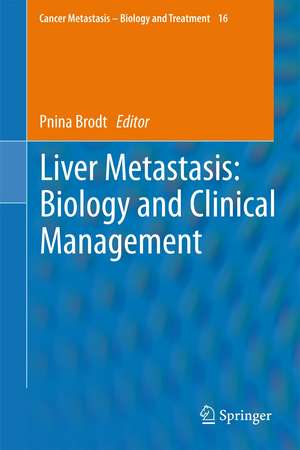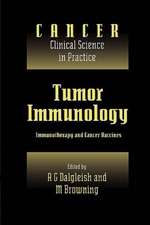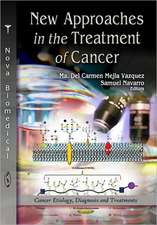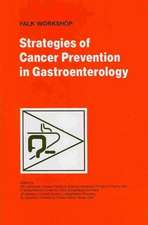Liver Metastasis: Biology and Clinical Management: Cancer Metastasis - Biology and Treatment, cartea 16
Editat de Pnina Brodten Limba Engleză Paperback – 21 apr 2013
Once cancer cells enter the liver, several different scenarios may occur. The cancer cells may be immediately destroyed by local defence mechanisms, they may enter a state of dormancy as solitary cells and never produce a metastasis, initiate a short-lived process of proliferation that is aborted before a metastasis is established or actively proliferate to form macrometastases. The chapters in Part I of this book provide insight into the cellular/molecular mechanisms that determine which of these scenarios prevails. Written by experts researchers in the filed of metastasis, these chapters provide state-of-the art reviews on the cellular and molecular processes that impact the early stages of the metastatic process. The unique microenvironment of the liver, its various anatomical, cellular and molecular features and the impact they have on metastasis are highlighted. In addition, the role of inflammation (pre-existing and tumor-induced), host innate and adaptive immune responses, cytokines, chemokines, growth factors and the unique molecular signatures of metastatic tumor cells are reviewed with an underscoring of thetranslational implications of the current state of knowledge.
Against this background, the chapters in Part II of the book provide critical reviews on major aspects of the clinical management of hepatic metastases. These include imaging strategies, surgical and chemotherapeutic treatment approaches and the use of targeted biological therapeutics such as anti-angiogenic drugs as treatment modalities.
By combining information on biological and clinical aspects of liver metastasis, this volume will serve as an excellent resource for scientists, clinicians, clinician/ scientists and trainees in the domains of oncology, surgical oncology, hepatobiliary physiology and radiology.
| Toate formatele și edițiile | Preț | Express |
|---|---|---|
| Paperback (1) | 1418.48 lei 6-8 săpt. | |
| SPRINGER NETHERLANDS – 21 apr 2013 | 1418.48 lei 6-8 săpt. | |
| Hardback (1) | 1423.02 lei 6-8 săpt. | |
| SPRINGER NETHERLANDS – 4 mar 2011 | 1423.02 lei 6-8 săpt. |
Din seria Cancer Metastasis - Biology and Treatment
- 5%
 Preț: 1102.31 lei
Preț: 1102.31 lei - 5%
 Preț: 1615.04 lei
Preț: 1615.04 lei - 5%
 Preț: 1110.32 lei
Preț: 1110.32 lei - 5%
 Preț: 1092.22 lei
Preț: 1092.22 lei - 5%
 Preț: 1417.17 lei
Preț: 1417.17 lei - 5%
 Preț: 1094.80 lei
Preț: 1094.80 lei - 5%
 Preț: 1092.79 lei
Preț: 1092.79 lei - 5%
 Preț: 1104.84 lei
Preț: 1104.84 lei - 5%
 Preț: 1095.73 lei
Preț: 1095.73 lei - 5%
 Preț: 1298.12 lei
Preț: 1298.12 lei - 5%
 Preț: 720.68 lei
Preț: 720.68 lei - 5%
 Preț: 1093.88 lei
Preț: 1093.88 lei - 5%
 Preț: 1092.43 lei
Preț: 1092.43 lei - 5%
 Preț: 1191.83 lei
Preț: 1191.83 lei - 5%
 Preț: 1101.21 lei
Preț: 1101.21 lei - 5%
 Preț: 1418.27 lei
Preț: 1418.27 lei - 5%
 Preț: 1424.31 lei
Preț: 1424.31 lei - 5%
 Preț: 1097.91 lei
Preț: 1097.91 lei
Preț: 1418.48 lei
Preț vechi: 1493.13 lei
-5% Nou
Puncte Express: 2128
Preț estimativ în valută:
271.46€ • 282.36$ • 224.11£
271.46€ • 282.36$ • 224.11£
Carte tipărită la comandă
Livrare economică 15-29 aprilie
Preluare comenzi: 021 569.72.76
Specificații
ISBN-13: 9789400735453
ISBN-10: 9400735456
Pagini: 460
Ilustrații: XIV, 446 p.
Dimensiuni: 155 x 235 x 24 mm
Greutate: 0.64 kg
Ediția:2011
Editura: SPRINGER NETHERLANDS
Colecția Springer
Seria Cancer Metastasis - Biology and Treatment
Locul publicării:Dordrecht, Netherlands
ISBN-10: 9400735456
Pagini: 460
Ilustrații: XIV, 446 p.
Dimensiuni: 155 x 235 x 24 mm
Greutate: 0.64 kg
Ediția:2011
Editura: SPRINGER NETHERLANDS
Colecția Springer
Seria Cancer Metastasis - Biology and Treatment
Locul publicării:Dordrecht, Netherlands
Public țintă
GraduateCuprins
BIOLOGY. 1. Cellular and molecular aspects of the liver architecture and function. 2. The tumor microenvironment at different stage of hepatic metastasis. 3. The Colorectal Cancer Initiating Cell: Markers and their role of in liver metastasis. 4. Role of CXC chemokines and receptors in liver metastasis – impact on liver resection-induced engraftment and tumor growth. 5. Role of Inflammation in the early stages of liver metastasis. 6. Signal transduction in tumor-endothelial cell communication. 7. Tumor dormancy in liver metastasis: clinical and experimental evidence and implications for treatment. 8. Role of the IGF- axis in liver metastasis: experimental and clinical evidence. 9. Breast Cancer Liver Metastasis. CLINICAL MANAGEMENT.10. Imaging of Hepatic Metastases. 11. Colorectal Carcinoma Liver Metastasis: Surgical Clinical Perspective. 12. Evaluation and Management of Liver Metastases from Non-Gastrointestinal Cancer. 13. Proteomic profiling of hepatic metastases: Paving the way to individualized therapy. 14. Targeting Angiogenesis in the Treatment of Hepatic Metastasis. 15. Uveal melanoma – a paradigm of site-specific liver metastasis.
Textul de pe ultima copertă
Liver metastases are a frequent and often fatal occurrence in cancer patients, particularly those with malignancies of the gastrointestinal (GI) tract. While recent improvements in surgical techniques and a more aggressive approach to resection of liver metastases have improved long term survival for some patients, most patients with hepatic metastases still succumb to their disease. To improve these dismal statistics, a better understanding of the biology of liver metastasis, particularly the early stages that can be targeted for prevention, is essential.
Once cancer cells enter the liver, several different scenarios may occur. The cancer cells may be immediately destroyed by local defence mechanisms, they may enter a state of dormancy as solitary cells and never produce a metastasis, initiate a short-lived process of proliferation that is aborted before a metastasis is established or actively proliferate to form macrometastases. The chapters in Part I of this book provide insight into the cellular/molecular mechanisms that determine which of these scenarios prevails. Written by experts researchers in the filed of metastasis, these chapters provide state-of-the art reviews on the cellular and molecular processes that impact the early stages of the metastatic process. The unique microenvironment of the liver, its various anatomical, cellular and molecular features and the impact they have on metastasis are highlighted. In addition, the role of inflammation (pre-existing and tumor-induced), host innate and adaptive immune responses, cytokines, chemokines, growth factors and the unique molecular signatures of metastatic tumor cells are reviewed with anunderscoring of the translational implications of the current state of knowledge.
Against this background, the chapters in Part II of the book provide critical reviews on major aspects of the clinical management of hepatic metastases. These include imaging strategies, surgical and chemotherapeutic treatment approaches and the use of targeted biological therapeutics such as anti-angiogenic drugs as treatment modalities.
By combining information on biological and clinical aspects of liver metastasis, this volume will serve as an excellent resource for scientists, clinicians, clinician/ scientists and trainees in the domains of oncology, surgical oncology, hepatobiliary physiology and radiology.
Once cancer cells enter the liver, several different scenarios may occur. The cancer cells may be immediately destroyed by local defence mechanisms, they may enter a state of dormancy as solitary cells and never produce a metastasis, initiate a short-lived process of proliferation that is aborted before a metastasis is established or actively proliferate to form macrometastases. The chapters in Part I of this book provide insight into the cellular/molecular mechanisms that determine which of these scenarios prevails. Written by experts researchers in the filed of metastasis, these chapters provide state-of-the art reviews on the cellular and molecular processes that impact the early stages of the metastatic process. The unique microenvironment of the liver, its various anatomical, cellular and molecular features and the impact they have on metastasis are highlighted. In addition, the role of inflammation (pre-existing and tumor-induced), host innate and adaptive immune responses, cytokines, chemokines, growth factors and the unique molecular signatures of metastatic tumor cells are reviewed with anunderscoring of the translational implications of the current state of knowledge.
Against this background, the chapters in Part II of the book provide critical reviews on major aspects of the clinical management of hepatic metastases. These include imaging strategies, surgical and chemotherapeutic treatment approaches and the use of targeted biological therapeutics such as anti-angiogenic drugs as treatment modalities.
By combining information on biological and clinical aspects of liver metastasis, this volume will serve as an excellent resource for scientists, clinicians, clinician/ scientists and trainees in the domains of oncology, surgical oncology, hepatobiliary physiology and radiology.
Caracteristici
Comprehensive and timely reviews on different aspects of the Biology of liver metastasis A unique combination of chapters on basic biological mechanisms and clinical aspects of liver metastasis written by experts in the respective fields Unlike other books now available on this subject, this book is not restricted to colon or GI cancers in its focus The Book will appeal to clinicians and laboratory scientists as well as trainees in both disciplines








